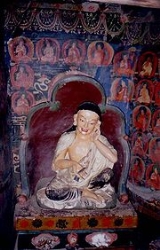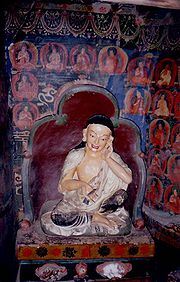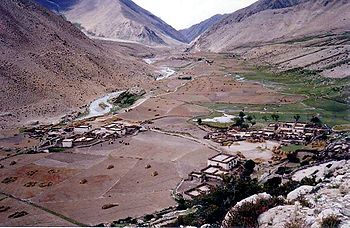
Milarepa
Encyclopedia

Jetsun Milarepa (c. 1052—c. 1135 CE
Common Era
Common Era ,abbreviated as CE, is an alternative designation for the calendar era originally introduced by Dionysius Exiguus in the 6th century, traditionally identified with Anno Domini .Dates before the year 1 CE are indicated by the usage of BCE, short for Before the Common Era Common Era...
) is generally considered one of Tibet
Tibet
Tibet is a plateau region in Asia, north-east of the Himalayas. It is the traditional homeland of the Tibetan people as well as some other ethnic groups such as Monpas, Qiang, and Lhobas, and is now also inhabited by considerable numbers of Han and Hui people...
's most famous yogi
Yogi
A Yogi is a practitioner of Yoga. The word is also used to refer to ascetic practitioners of meditation in a number of South Asian Religions including Jainism, Buddhism, and Hinduism.-Etymology:...
s and poets. He was a student of Marpa Lotsawa
Marpa Lotsawa
Marpa Lotsawa , sometimes known fully as Lhodak Marpa Choski Lodos or commonly as Marpa the Translator, was a Tibetan Buddhist teacher credited with the transmission of many Buddhist teachings to Tibet from India, including the teachings and lineages of Vajrayana and Mahamudra.-Biography:Born as...
, and a major figure in the history of the Kagyu
Kagyu
The Kagyu, Kagyupa, or Kagyud school, also known as the "Oral Lineage" or Whispered Transmission school, is today regarded as one of six main schools of Himalayan or Tibetan Buddhism, the other five being the Nyingma, Sakya, Jonang, Bon and Gelug...
(Bka'-brgyud) school of Tibetan Buddhism
Tibetan Buddhism
Tibetan Buddhism is the body of Buddhist religious doctrine and institutions characteristic of Tibet and certain regions of the Himalayas, including northern Nepal, Bhutan, and India . It is the state religion of Bhutan...
.
Life
Born in the village of Kya Ngatsa - also known as TsaTSA
TSA most often refers to:* Transportation Security Administration, in the United States Department of Homeland Security* Tourette Syndrome Association, advocacy organizationbut may also refer to:- Organizations :...
- in Gungthang
Mangyül Gungthang
Mangyül Gungthang ) alternatively known as Ngari Me is the name of a Tibetan kingdom established under Sa-skya overlordship in Southwest Tibet around 1265. Historically it lies in an area that was an important transit point between the north and south Himalayas, and it was through this route...
province of western Tibet to a prosperous family he was named Mila Thöpaga (Thos-pa-dga'), which means "A joy to hear." His family name, Josay indicates noble descent, a sept
Sept
A sept is an English word for a division of a family, especially a division of a clan. The word might have its origin from Latin saeptum "enclosure, fold", or it can be an alteration of sect.The term is found in both Ireland and Scotland...
of the Khyungpo or eagle clan. When his father died, Milarepa's uncle and aunt took all of the family's wealth. At his mother's request, Milarepa left home and studied sorcery
Magic (paranormal)
Magic is the claimed art of manipulating aspects of reality either by supernatural means or through knowledge of occult laws unknown to science. It is in contrast to science, in that science does not accept anything not subject to either direct or indirect observation, and subject to logical...
. While his aunt and uncle were having a party to celebrate the impending marriage of their son, he took his revenge by summoning a giant hail storm to demolish their house, killing 35 people, although the uncle and aunt are supposed to have survived. The villagers were angry and set off to look for Milarepa, but his mother got word to him and he sent a hailstorm to destroy their crops.
Many of Milarepa's deeds took place in Chokyi Dronma's homeland and his life and songs were compiled by Tsangnyon Heruka, sponsored by Chokyi Dronma's brother, the Gungthang king Thri Namgyal De.
Milarepa later lamented his evil ways in his older years: "In my youth I committed black deeds. In maturity I practiced innocence. Now, released from both good and evil, I have destroyed the root of karmic action
Karma
Karma in Indian religions is the concept of "action" or "deed", understood as that which causes the entire cycle of cause and effect originating in ancient India and treated in Hindu, Jain, Buddhist and Sikh philosophies....
and shall have no reason for action in the future. To say more than this would only cause weeping and laughter. What good would it do to tell you? I am an old man. Leave me in peace."
Supernatural running
According to the book Magic and Mystery in Tibet by French explorer Alexandra David-NéelAlexandra David-Néel
Alexandra David-Néel born Louise Eugénie Alexandrine Marie David was a Belgian-French explorer, spiritualist, Buddhist and writer, most known for her visit to Lhasa, Tibet, in 1924, when it was forbidden to foreigners...
, Milarepa boasted of having “crossed in a few days, a distance which, before his training in black magic
Black magic
Black magic is the type of magic that draws on assumed malevolent powers or is used with the intention to kill, steal, injure, cause misfortune or destruction, or for personal gain without regard to harmful consequences. As a term, "black magic" is normally used by those that do not approve of its...
, had taken him more than a month. He ascribes his gift to the clever control of ‘internal air’.” David-Néel comments “that at the house of the lama who taught him black magic there lived a trapa [monk] who was fleeter than a horse” using the same skill.
This esoteric skill, which is known as Lung-gom-pa ("Wind Meditation", lung = “wind, gom-pa = “meditation”) in Tibet, allows a practitioner to run at an extraordinary speed for days without stopping. This technique could be compared to that practiced by the Kaihigyo Monks of Mt. Hiei in Kyoto
Kyoto
is a city in the central part of the island of Honshū, Japan. It has a population close to 1.5 million. Formerly the imperial capital of Japan, it is now the capital of Kyoto Prefecture, as well as a major part of the Osaka-Kobe-Kyoto metropolitan area.-History:...
, Japan
Japan
Japan is an island nation in East Asia. Located in the Pacific Ocean, it lies to the east of the Sea of Japan, China, North Korea, South Korea and Russia, stretching from the Sea of Okhotsk in the north to the East China Sea and Taiwan in the south...
.
Tutelage under Marpa

Lama
Lama is a title for a Tibetan teacher of the Dharma. The name is similar to the Sanskrit term guru .Historically, the term was used for venerated spiritual masters or heads of monasteries...
and was led to Marpa
Marpa Lotsawa
Marpa Lotsawa , sometimes known fully as Lhodak Marpa Choski Lodos or commonly as Marpa the Translator, was a Tibetan Buddhist teacher credited with the transmission of many Buddhist teachings to Tibet from India, including the teachings and lineages of Vajrayana and Mahamudra.-Biography:Born as...
the translator. Marpa proved a hard taskmaster. Before Marpa would teach Milarepa he had him build and then demolish three towers in turn. When Marpa still refused to teach Milarepa he went to Marpa's wife, who took pity on him. She forged a letter of introduction to another teacher, Lama Ngogdun Chudor, under whose tutelage he practised meditation
Meditation
Meditation is any form of a family of practices in which practitioners train their minds or self-induce a mode of consciousness to realize some benefit....
. However when he was making no progress, he confessed the forgery and Ngogdun Chudor said that it was vain to hope for spiritual growth without the guru Marpa's approval. Milarepa returned to Marpa, and after practicing very diligently for twelve years Milarepa attained the state of Vajradhara
Vajradhara
Vajradhara is the ultimate primordial Buddha, or Adi Buddha, according to the Gelug and Kagyu schools of Tibetan Buddhism.In the evolution of Indian Buddhism, Vajradhara gradually displaced Samantabhadra, who remains the...
(complete enlightenment). He is said to be the first to achieve this state within one lifetime. He then became known as Milarepa, which means the "Mila, the cotton clad one" (the suffix "repa" is given to many tantric yogis since they wear white robes) At the age of forty-five, he started to practice at Drakar Taso (White Rock Horse Tooth) cave - 'Milarepa's Cave
Milarepa's Cave
Milarepa's Cave or Namkading Cave is a cave where the great Tibetan Buddhist philosopher, and Vajrayana Mahasiddha, Milarepa Milarepa's Cave or Namkading Cave is a cave where the great Tibetan Buddhist philosopher, and Vajrayana Mahasiddha, Milarepa Milarepa's Cave or Namkading Cave is a cave where...
', as well as becoming a wandering teacher. Here, he subsisted on nettle
Stinging nettle
Stinging nettle or common nettle, Urtica dioica, is a herbaceous perennial flowering plant, native to Europe, Asia, northern Africa, and North America, and is the best-known member of the nettle genus Urtica...
tea, leading his skin to turn green, hence the greenish color he is often depicted as having in paintings and sculpture.
Pyenzhangling Monastery, also known as Pelgye Ling Gompa, is a small Tibetan Buddhist monastery in a tiny village called Zhonggang
Zhonggang
Zhonggang is a township-level division situated in Fuyang, Anhui, China....
, Tibet
Tibet
Tibet is a plateau region in Asia, north-east of the Himalayas. It is the traditional homeland of the Tibetan people as well as some other ethnic groups such as Monpas, Qiang, and Lhobas, and is now also inhabited by considerable numbers of Han and Hui people...
that is consecrated to Milarepa. It is built around the cave
Milarepa's Cave
Milarepa's Cave or Namkading Cave is a cave where the great Tibetan Buddhist philosopher, and Vajrayana Mahasiddha, Milarepa Milarepa's Cave or Namkading Cave is a cave where the great Tibetan Buddhist philosopher, and Vajrayana Mahasiddha, Milarepa Milarepa's Cave or Namkading Cave is a cave where...
where he once lived. "It was destroyed but has now been rebuilt and decorated by Nepali artisans. This is one of many caves associated with Milarepa between Langtang
Langtang
Langtang is a region in Nepal to the north of Kathmandu and bordering Tibet. It is protected as Langtang National Park and has a number of high peaks including Langtang Lirung . As of 2010, the entrance ticket to the park cost 2400 Nepali Rupees for foreigners.About 4,500 people live inside the...
and Jomolungma
Mount Everest
Mount Everest is the world's highest mountain, with a peak at above sea level. It is located in the Mahalangur section of the Himalayas. The international boundary runs across the precise summit point...
."
Lineage
Milarepa is famous for many of his songs and poems, in which he expresses the profundity of his realization of the dharmaDharma
Dharma means Law or Natural Law and is a concept of central importance in Indian philosophy and religion. In the context of Hinduism, it refers to one's personal obligations, calling and duties, and a Hindu's dharma is affected by the person's age, caste, class, occupation, and gender...
. He also had many disciples, male and female, including Rechung Dorje Drakpa
Rechung Dorje Drakpa
Rechung Dorje Drakpa [1083/4-1161], known as Rechungpa, was one of the two most important students of the 11th century Kagyu yogi and poet Milarepa...
(Ras-chung Rdo-rje Grags-pa) and Gampopa
Gampopa
Gampopa Sonam Rinchen "Sonam Rinchen from Gampo" — who was equally well known in Tibet as Dagpo Lhaje , Nyamed Dakpo Rinpoche , and Da'od Zhonnu , — establishedthe Kagyu school, one of the four major schools of Tibetan Buddhism today, as an...
(Sgam-po-pa, Dhakpo Lhaje). His female disciples include Rechungma, Padarbum, Sahle Aui and Tsheringma
Tsheringma
Tsheringma is a herbal tea made in Bhutan. The name is derived from the Bhutanese Goddess of longevity, wealth and prosperity.It is taken as a Bhutanese traditional medicine, giving a soothing and refreshing sensation internally and is believed to improve the conditions of the heart, liver, and the...
. It was Gampopa who became Milarepa's spiritual successor, continued his lineage, and became one of the main lineage masters in Milarepa's tradition.
Further reading
- The Life of Milarepa, translated by Andrew Quintman, Penguin Classics, 2010, ISBN 978-0143106227
- The Life of Milarepa, translated by Lobsang P. Lhalungpa, Book Faith India, 1997, ISBN 81-7303-046-4
- Milarepa: Songs on the Spot, translated by Nicole Riggs, Dharma Cloud Press, 2003, ISBN 0-9705639-3-0
- Milarepa, The Hundred Thousand Songs of Milarepa, translated by Garma C.C. Chang, City Lights Books, 1999, ISBN 1-57062-476-3
- Tibet's Great Yogī Milarepa: A Biography from the Tibetan. Edited by W. Y. Evans-Wentz. 1928. Oxford University Press. Paperback reprint 1974.
- The Yogi's Joy: Songs of Milarepa Sangharakshita, Windhorse Publications, 2006, ISBN 1-899579-66-4
- Drinking the Mountain Stream: Songs of Tibet’s Beloved Saint, Wisdom Publications, ISBN 0-86171-063-0repa/10-1/mila1-0.htm Milarepa the great Tibetan saint] Dharmapala Thangka Centre, School of Thangka Painting
External links
- Milarepa in the Treasury of Lives
- Biography on Kagyu website
- The life of Milarepa
- Milarepa meets Padampa Sangye
- The Magic life of Milarepa in comic book form.
- The sixty songs of Milarepa
- Text, The Essential Songs of Milarepa in English
- Inviting the demon. (Milarepa, Tibetan Buddhism)(The Shadowissue) Judith Simmer-Brown, Parabola Vol.22 No.2 (Summer 1997) pp. 12–18
- Movie, Milarepa, 1 of 2
- Gallery of Milarepa Thangkas by Dharmapala Thangka Centre

